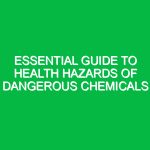Introduction
In today’s industrial and laboratory environments, understanding the principles of safe chemical handling is crucial for ensuring health, safety, and environmental (HSE) compliance. A chemical, defined as a substance with a defined composition, plays a significant role in various sectors, from manufacturing to healthcare. Proper management of chemicals can prevent accidents, reduce environmental impact, and safeguard the health of workers and the surrounding community. This article delves into the essential aspects of safe chemical handling, focusing on the chemical known as acetone, which is frequently used in laboratories and industries.
The Role of Acetone in Various Industries
Acetone, or propan-2-one, is a colorless, volatile organic compound widely recognized for its solvent properties. It is commonly utilized in the production of plastics, pharmaceuticals, and cosmetics. Due to its effectiveness in dissolving many organic compounds, acetone is a staple in laboratories for cleaning glassware and as a solvent in chemical reactions.
Understanding Acetone
Acetone has a molecular formula of C3H6O and is classified as a ketone. Its low boiling point (56°C) and high evaporation rate make it a favorable choice in various applications, but these same properties also pose Safety risks if not managed properly. It is important to recognize both the utility and the potential Hazards associated with acetone to effectively implement Safety Measures.
Key Aspects of Safe Chemical Handling
When handling acetone, or any chemical, the principles of Safety should be paramount. Here are several key aspects of safe chemical handling relevant to HSE:
- Proper Training: Employees should receive adequate training on the properties, hazards, and safe handling practices of acetone. Training should be ongoing to ensure that employees remain aware of any updates in safety protocols or Regulations.
- Personal Protective Equipment (PPE): Workers should be equipped with the appropriate PPE, such as gloves, goggles, and lab coats, to protect against potential splashes or spills of acetone.
- Ventilation: Adequate ventilation is essential in areas where acetone is used. Local exhaust ventilation systems can help reduce inhalation exposure to vapors that may be harmful.
- Storage: Acetone should be stored in a cool, well-ventilated area away from heat sources and incompatible substances. Use proper containers that are clearly labeled to prevent accidental misuse.
- Emergency Procedures: Establish clear emergency procedures in case of a spill or exposure. This includes having eyewash stations, safety showers, and spill kits readily available.
Potential Hazards and Risks
Despite its usefulness, acetone poses several hazards if not handled correctly. Understanding these risks is key to mitigating them:
- Flammability: Acetone is highly flammable; its vapors can ignite easily. It is crucial to keep acetone away from open flames, sparks, and hot surfaces.
- Health Risks: Inhalation of acetone vapors can lead to respiratory irritation and central nervous system Effects. Prolonged exposure may cause headaches, dizziness, or confusion.
- Environmental Concerns: If released into the Environment, acetone can contaminate water sources and affect aquatic life. Proper disposal methods must be followed to mitigate this risk.
Best Practices for Chemical Handling
Implementing Best Practices for chemical handling can significantly reduce the risks associated with acetone. Here are some actionable insights:
1. Conduct Risk Assessments
Before beginning any work with acetone, perform a thorough risk assessment to identify potential hazards. This assessment should evaluate the work environment, equipment, and procedures to ensure all risks are accounted for.
2. Maintain a Chemical Inventory
Keeping an updated inventory of all chemicals, including acetone, allows for better tracking of usage and storage. This practice aids in ensuring that chemicals are stored correctly and can help during emergencies by providing first responders with necessary information.
3. Implement Standard Operating Procedures (SOPs)
SOPs should outline the step-by-step processes for using acetone safely. This includes handling, storage, and disposal methods. Regularly review and update these procedures to reflect any changes in safety regulations or Best Practices.
4. Ensure Proper Disposal
Disposal of acetone must be handled according to local regulations. Acetone should never be poured down the drain or discarded in regular trash. Instead, it should be collected in designated waste containers and disposed of through a licensed hazardous waste disposal service.
Real-Life Examples of Chemical Handling
To illustrate the importance of safe chemical handling, consider the case of a laboratory that experienced a significant acetone spill due to improper storage. In this instance, the acetone was stored near a heat source, which caused the container to rupture. The vapors quickly filled the room, leading to a fire that damaged equipment and posed serious health risks to the staff.
This incident prompted the laboratory to re-evaluate its chemical handling practices. They implemented comprehensive training programs, improved storage conditions, and updated their emergency response plan. As a result, they significantly reduced the risk of future incidents and fostered a safer working environment.
Regulations and Standards Governing Chemical Handling
Understanding the regulations surrounding acetone and other chemicals is essential for HSE compliance. In many countries, there are specific regulations governing the use, handling, and disposal of hazardous chemicals. Key regulations include:
- Occupational Safety and Health Administration (OSHA): osha provides guidelines for ensuring safe working conditions. Employers must comply with the Hazard Communication Standard (HCS), which requires proper labeling and safety data sheets (SDS) for all hazardous chemicals, including acetone.
- Environmental Protection Agency (EPA): The EPA regulates the disposal of hazardous waste, including acetone. Proper disposal methods must adhere to the Resource Conservation and Recovery Act (RCRA) to protect the environment.
- Local Regulations: Many states and municipalities have additional regulations regarding chemical handling. It is crucial to be aware of and comply with these local laws, as they can differ from federal requirements.
Conclusion
The safe handling of acetone, like any chemical, is not only a regulatory requirement but a moral imperative to protect human health and the environment. By understanding the properties and hazards associated with acetone and implementing best practices for its handling, organizations can create safer workplaces. Training, proper storage, and adherence to regulations play critical roles in minimizing risks.
As industries continue to innovate, the importance of Chemical Safety will only grow. It is essential that organizations remain vigilant, proactive, and committed to the principles of HSE. By fostering a culture of safety, we can unlock the secrets of effective chemical handling, ensuring a safer future for everyone involved.


